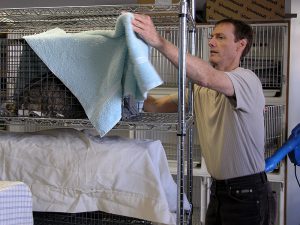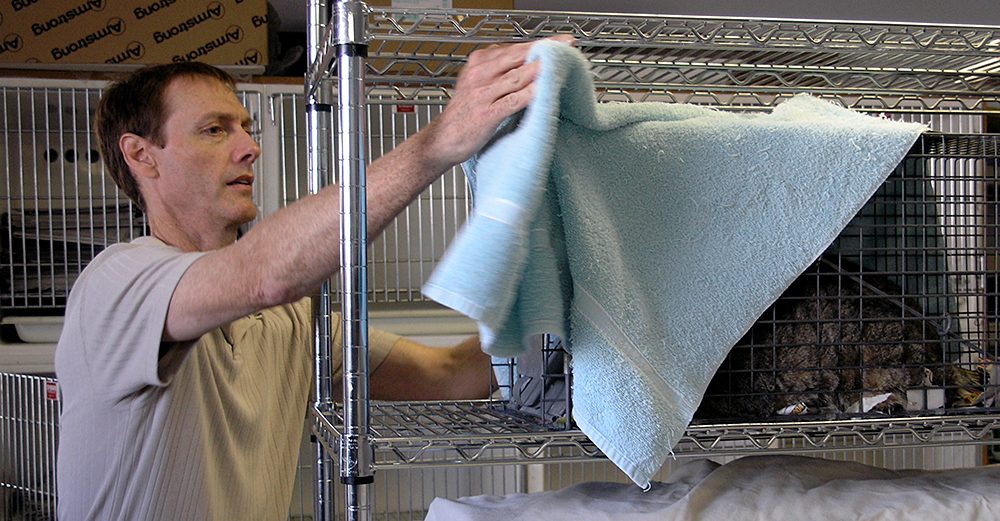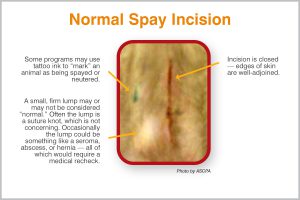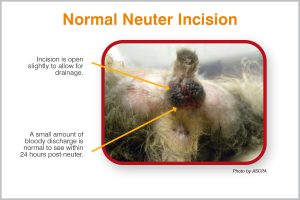
Postsurgical Checklist
- Prepare carefully before leaving the clinic. Discharge from the clinic can be rushed and stressful, so prepare to be focused and calm, and make sure to do a complete check of everything before you leave. Confirm that you have all of the exact same cats and traps that you brought in; although rare, mix-ups can happen. Check that all traps are securely hooked or fastened shut, using zip ties for added security if necessary. Each trap should be lined with clean newspaper or absorbent pads. Be sure all cats have been eartipped if requested and that clinic ID collars and e-collars have been removed. Be sure to collect medical records, including rabies vaccination certificates, and put them in a safe place. By the time you are ready to leave the clinic, the cats may be sitting up but they are not yet fully recovered from the anesthesia. This means the cats will be unable to regulate their body temperature, so it will be important that they are not exposed to extreme temperatures during transit from the clinic to their recovery space.
- Allow the cats to recover in an appropriate space. Keep the cats indoors in their covered traps in a temperature-controlled environment. Make sure they are on dry bedding, and not exposed to loud noises, toxic fumes, other animals, or people who are not trained TNR caretakers. It takes about 24 hours for the cats to fully recover from anesthesia and regain the ability to regulate their body temperature. So it is important that the recovery location be temperature-controlled to keep the cats from getting too hot or too cold. Ideally, the room should be kept to about 70 degrees. If you are using space heaters or fans, keep them a safe distance from the cats so the cats will not overheat or get too cold. Take particular care in large spaces, which can be difficult to regulate. (Learn more about creating safe, effective TNR recovery spaces in Hold That Tiger! TNR Holding Space Tips.)
- Put safety first. Keep the traps covered to reduce the cats’ stress. Never open trap doors without inserting a trap divider first, and never allow the cats out of the traps. Do not stick your fingers through the bars or attempt to handle the cats.
-
Monitor the cats carefully during the first 24 hours after surgery. Check the cats often for their progress. If you notice bleeding, swelling, lethargy, vomiting, labored breathing, or if a cat is not fully waking up, seek veterinary assistance immediately. Lack of appetite is a concern, but be aware that many healthy cats will refuse to eat in a trap.
It’s best if you start taking notes on the general behavior and eating habits of each individual cat during the trapping and holding period prior to surgery. This will provide an excellent baseline to compare against a cat’s behavior during postsurgical recovery. If a cat is not eating after surgery, for example, it’s important to know whether the cat was eating before surgery. Many healthy cats will refuse to eat in a trap, and you may want to shorten the recovery period for them.
The incisions on each female cat should be checked daily until she is released, to ensure there is no bleeding, swelling, or discharge. You may need to prop the trap up between tables, or have a friend hold the trap up, so you can shine a flashlight up on the cat’s belly to get a look at the incision. The photos below show normal spay and neuter incisions.
When cats are first returned from the clinic, a small amount of blood spotting on the trap lining is not necessarily cause for alarm. If you see pooling of blood, or if bleeding persists, contact the veterinarian.
- Keep the traps clean. Use a trap divider to keep the cat on one end of the trap while you replace soiled newspaper and spot-clean the trap with a nontoxic cleaner and paper towels as needed. This should be done at least twice a day, usually at the same time as feeding. Placing food and water after cleaning can minimize spillage. Inserting the divider through the sides of the trap is more secure than inserting it through the top of the trap, since the divider would simply be resting on the trap liner rather than protruding through the bottom mesh of the trap. A cat could easily push past the divider if it is not securely inserted through both sides of the trap. Many experienced trappers use two dividers for added security.
-
Feed and provide the cats with water after they regain consciousness. Wait eight hours after surgery before feeding adult cats. When feeding the cats, always have a trap divider or isolator firmly in place between you and the cat before opening the traps. Two dividers or isolators are better than one. An isolator is essential, especially if you have a trap that does not have a back door. Always relock the trap door. If you are working in a group, make sure the tasks are clearly assigned so there is no risk of a cat escaping or not receiving care.
Kittens under four months of age most likely will have been given oral dextrose (sugar water) at the clinic to avoid hypoglycemia, but make it a priority to feed young kittens immediately after you have brought them back from the clinic. This will help to speed their recovery. Young kittens have a speedy metabolism and can be safely fed two to three hours before surgery and immediately upon waking up from anesthesia.
- Hold cats until they recover. Cats usually need to be held for 24 to 72 hours after surgery, depending on their recovery speed. Male cats can be returned to the trapping site 24 hours following neutering, as long as they are fully awake and do not require further medical attention. Females need 48 to 72 hours of recovery, depending on their specific circumstances. You may return nursing mothers 24 hours following surgery, once they completely regain consciousness, so they can get back to their kittens. Forty-eight hours is sufficient for a routine spay, and 72 hours is recommended if the cat was pregnant. Make sure all cats are fully conscious, clear-eyed, and alert before release, and check the incision on females once more before releasing them. A small amount of redness is normal, but puffy swelling or bleeding at the suture site warrants veterinary attention.
Our reference in preparing this article was the Guide to Trap-Neuter-Return (TNR) and Colony Care offered to every attendee of the Alley Cat Allies/ASPCA/Mayor’s Alliance for NYC’s Animals Trap-Neuter-Return (TNR) and Colony Care Workshop since July 2014. If you do not already have a copy of this valuable resource to all-things-TNR in New York City, we invite you to take our workshop to become a Certified TNR Caretaker. You will receive a copy of the guide at the workshop.
To learn more about pre- and postsurgical care of community cats during TNR projects, please attend our TNR certification workshop, or our specialty workshop, In-Trap Care of TNR Cats (date to be announced).




